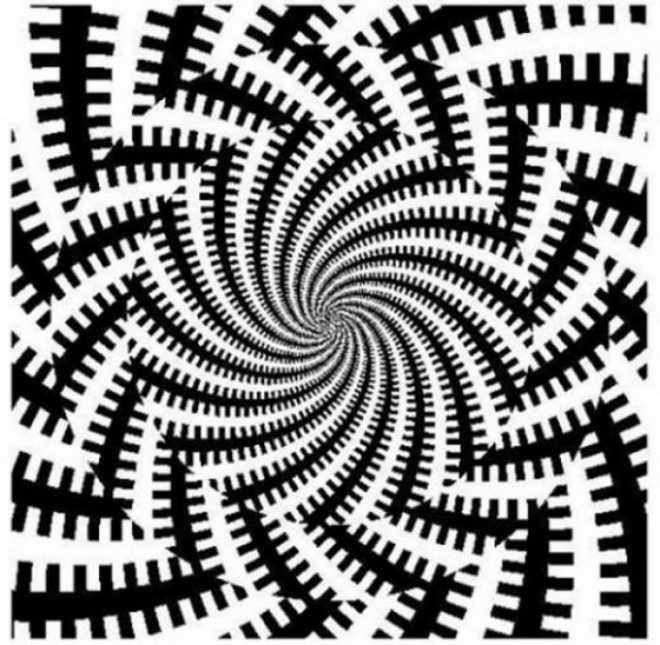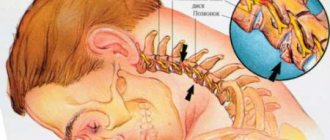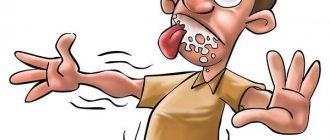The feeling of not being included, as if everything is happening “not to me” is one of the common symptoms of derealization in vegetative-vascular dystonia
Derealization in VSD is a symptom accompanied by a subjectively distorted perception of objects, people, and the surrounding world. Of all the complex and diverse symptom complex of autonomic disorder, “dereal” is distinguished by the greatest specificity. Unless a “classic” panic attack can compete in the strength of the emotions generated.
In the case of derealization, a person is seized not by the fear of death, but by the “anticipation” of madness. Fortunately, a neurotic disorder is significantly different from a real mental illness, but a person’s quality of life deteriorates in either variant.
Derealization during VSD - how is it treated and where can I find a pill for an adequate perception of reality, without specific sensations?
Depersonalization and derealization

The terms are often defined as one disorder syndrome, although both the manifestations and sensations of patients have significant differences.
- Derealization refers to a sharp change in the subject’s perception of the world that surrounds him. It captures all aspects and characteristics of reality - space, time, light and sound factors and even aromas. The distortion can be either in the direction of attenuation of the sharpness of understanding, or in the direction of a jump in sharpness, aggravation of feelings.
Note! If the problem is not corrected soon after the onset of attacks, it will progress and the understanding of not only the external environment, but also the individual himself, will be distorted.
- Depersonalization in VSD – its manifestations relate to the identification of one’s “I”. There is a feeling of detachment, as if he is watching a movie rather than living his own life. The surrounding world fades, it seems gray, flat and like bad scenery, the mood as such disappears. It is often difficult for the patient to think, he temporarily loses memory, even masterpieces of art do not awaken any feelings. Prolonged stay in such stupor can provoke suicide.
The difference between disorders in vegetative-vascular dystonia and problems managed by a psychiatrist is that the patient is able to fully control his actions and is clearly aware that something is going wrong.
Drug therapy
Your doctor will tell you how to treat derealization. The treatment program involves taking:
- nootropics;
- antioxidants;
- cytoprotectors;
- antidepressants with sedative effects;
- antipsychotics.
Among the nootropics for derealization, Noocetam is prescribed, and among the antioxidants, Mexidol. Cytoflavin is considered the most powerful cytoprotector. The best antipsychotic is Sonapax. Among the antidepressants for derealization, Paroxetine is often prescribed.
Vitamins help the patient recover. The doctor also prescribes sedatives and antidepressants. If improvements do not occur, tranquilizers are prescribed.
If the patient’s condition remains serious, the attending physician makes a decision to place him in a hospital.
Lamotrigine for derealization
One of the most powerful drugs is Lamotrigine. It was originally used in the treatment of epilepsy. Lamotrigine is prescribed concomitantly with inhibitors that reuptake serotonin. The medicine allows you to get rid of some symptoms of the disorder and provides an antidepressant effect.
Lamotrigine helps improve cognitive functioning in humans. Taking it helps normalize memory. Lamotrigine protects nerve cells and reduces the release of glutamate. Against the background of its use, the effect of other drugs is enhanced.
Lamotrigine has also been successfully used in the treatment of depersonalization.
Paroxetine for derealization
The drug Paroxetine helps combat derealization. It is a selective inhibitor of serotonin reuptake by neurons in the brain. Paroxetine is prescribed both in hospital and outpatient treatment. The drug is not prescribed to persons under 14 years of age.
Paroxetine is taken 1 time/24 hours, preferably in the morning. It is best to take the medicine with food. Paroxetine may have effects on the central nervous system, autonomic nervous system and cardiovascular system. Therefore, the medicine is prescribed with caution.
Causes and risk group

Depersonalization and derealization are provoked by oppression of the human psyche by excessive stress, staying in deprivation - conditions in which it is impossible to satisfy minimal needs and feel comfort.
For your information. Chronic deprivation is usually used to explain the high ambition of patients with vegetative-vascular dystonia and their tendency to perfectionism.
Other factors that provoke nervous system disorders include:
- long-term moral fatigue;
- chronic physical fatigue;
- frequent situations of severe stress;
- fear of society, contacts and connections with other people;
- ignoring and denying your needs at all levels of the mind;
- long depression;
- seclusion, escape from communication;
- use of certain psychotropic and narcotic medications;
- significant life events that caused physical or mental harm.
The feeling of unreality is a way of protecting the brain from emotional overloads that it cannot withstand. This is similar to the effect when an injured part of the body loses sensation so that the person does not die from painful shock.
The risk group for derealization includes young people under 25 years of age, especially teenagers. Young and inexperienced people take all experiences and events to heart, and therefore experience stress. The risk also increases for introverts who tend to avoid contact with other people.
How you can help
The answer to the question whether it is possible to get rid of derealization is positive. Therapy includes:
- psychoanalysis;
- cognitive behavioral psychotherapy;
- improvement of living conditions;
- taking medications.
If a person has been diagnosed with derealization, then the answer to the question of how to get rid of painful symptoms can be obtained during cognitive behavioral psychotherapy.
The main goal of this treatment method is to restore three personal levels:
- Behavioral.
- Emotional.
- Cognitive.
Muscle relaxation is used. A person is taught to get rid of emotional clamps. As a result, the patient can control the attacks.
How to get rid of derealization yourself? Timely preventative measures can help. These include:
- Daily walks.
- Doing physical exercise.
- Dieting.
- Active communication with people.
It is advisable to take a walk in a park or near a natural body of water. The optimal time of day is morning or early evening. The duration of the walk is 1.5-2 hours.
Physical activity during derealization should not be very great. It is recommended to prefer light fitness aerobics or regular jogging to strength training.
It is recommended to exclude stimulating foods from the diet. It is advisable to stop drinking chocolate, coffee, and alcohol. Quitting smoking and taking heavy drugs is important.
Symptoms and provoking factors

- A persistent feeling of fantasticality, familiar things look unfamiliar and alien. The patient is unable to explain in detail how the world has changed beyond recognition and to formulate what exactly has changed. Descriptive sentences are vague and lack specific statements. They are replete with phrases “like”, “as if”, “probably”, as if there is a construction of a hypothesis rather than a description of the observed reality.
- With severe symptoms of severe derealization, the patient loses his sense of reality completely. He may get lost in a previously familiar place, forget what he ate or did during the day, or that he even really exists.
- Perception of external objects as in a dream or through a dusty curtain.
- Problems with temporal and spatial orientation, sensation of noises and smells.
- Distrust of what is happening.
- Fear of madness, chronic feeling of déjà vu.
Circumstances that provoke the condition are:
- Difficulties in studying.
- Problems and conflicts during working hours.
- Low ecology in the city of residence.
- Poor relationships with others.
- Lack of physical comfort and personal space - traveling in crowded public transport, living in a place that is in poor condition.
Visual distortions

Sometimes the outlines become wavy, the picture of the world ripples before the eyes. The occurrence of tunnel vision syndrome is observed, i.e. inability to see objects on the sides - they are completely indistinguishable.
The brightness of colors decreases or increases unnaturally, reality seems to be a cartoon or a drawing, against its background multi-colored circles may flash, spreading out in breadth, as if they are running along the surface of water.
Auditory distortion
The manifestation of hearing problems is expressed in a person’s complaints that:
- the speech of his interlocutors is heard incredibly slow and crumpled, similar to recording on old records;
- background noise (streets, music) is indistinguishable, but single sharp sounds hit the hearing organs;
- one’s own steps can be heard deafeningly;
- ringing in the ears or stuffy ears.
Spatial distortions
- The ground disappears from under the patient’s feet, dizziness or nausea occurs.
- Problems arise with assessing distances - it seems that some object is distant, while it is close.
- It is difficult to go around obstacles and walk on a clear surface - those suffering from derealization crash into door frames, stumble on the floor and fall down stairs.
- The feeling of deja vu does not go away, amnesia or a feeling of frozen time may occur.
Olfactory distortions

Odor hallucinations are possible. Many foods and things, the smell of which was pleasant to a person with a vegetative disorder, he can no longer enjoy - everything seems disgusting to him. Pleasant fragrances are also seen, but if they haunt the patient, they cause irritation. The patient may smell a scent that does not exist at all in the world or is completely unfamiliar to him, or remember odor sensations associated with a significant event.
Panic attacks
Osteochondrosis of the neck leads to periodic panic attacks, the duration of which ranges from 2-3 minutes to several hours. Attacks can occur up to several times a day or be limited to a couple or three problems per month. On average, an attack lasts about half an hour, while the patients themselves cannot name the reason that led to such problems. With a deeper analysis of the situation, the apparent spontaneity can be dispelled and the cause of the attack can be identified.
The most common causes of panic attacks with cervical osteochondrosis can be:
- physical exercise;
- mental stress;
- pressure on the cervical spine;
- staying in one uncomfortable position for a long time;
- sharp fluctuations in weather conditions.
A person who has experienced a panic attack begins to experience fear. He is afraid of a second attack, which leads to further deterioration of the condition.
If a person suffers from constant headaches, this symptom cannot be ignored. You should contact the clinic for testing. Most often, pain is caused by pinched nerve endings in the cervical spine. If we neglect these manifestations, then the treatment of cervical osteochondrosis will become quite lengthy and not effective in all cases. Therefore, you should contact specialists as soon as possible.
Diagnosis of the disease
In a personal conversation with a potential patient, the specialist is interested in:
- are there people in the interlocutor’s family who have experienced attacks of derealization;
- what kind of relationship does he have with his family?
- whether the person uses alcoholic beverages or drugs, psychotropic medications;
- whether there were suicidal desires and thoughts;
- whether there is brain damage as a result of trauma.
Friends and relatives of the patient answer similar questions. The condition of his skin and natural body reflexes are examined.

The problem is easily diagnosed: difficulties in expressing and formulating thoughts, constant listening, looking into everything that is happening, a face distorted from seemingly unpleasant aromas make it clear that a person’s sense of the world is suffering. This means that derealization is observed.
If necessary, the doctor writes a referral for the following studies:
- X-ray examination;
- Ultrasound of the brain;
- EEG in a sleeping state.
The disease is accompanied not only by the observation of a subjectively distorted picture of the world, but also by a decrease in the synthesis of norepinephrine, serotonin and some organic acids in the body. Based on the picture obtained as a result of an additional examination, a scheme of health-improving measures is developed.
Symptoms of the disease
Manifestations of derealization in osteochondrosis can occur in one or several directions of perception:
- Distortion of vision (the contours of objects change, lateral vision is greatly deteriorated, the image ripples, a change in color perception is possible);
- Distortion of hearing (complaints of noise/hum/ringing in the ears, the voices of familiar people are difficult to recognize, individual rhythmic sounds stand out very loudly - for example, your own steps);
- Time distortion (the patient notes a feeling of time slowing down or a déjà vu effect, short-term memory loss is possible);
- Distortion of space assessment (it is difficult for the patient to estimate the distance to a particular object, the height of steps, his own height);
- Distortion of sensations (complaints of tingling in the limbs, goosebumps, itching).
Therapeutic course
What to do first?
When treating derealization, the most important thing is to eliminate the factors that cause discomfort and cause negative emotions. As much positive, joyful and pleasant things as possible are brought into the patient’s life to help him relieve psychological stress.
During an attack of the disease, to stop it it is necessary:
- normalize your breathing and try to relax;
- think that what is happening is not a sign of madness, but just temporary difficulties;
- focus attention on one object, do not look at everything around;
- fill your mind with calm, neutral thoughts.
Drug therapy

If the problem becomes serious, the following medications are prescribed to temporarily relieve anxiety:
- tranquilizers (Phenazepam);
- antidepressants with anti-anxiety effect and antipsychotics;
- serotonin uptake inhibitors + anticonvulsant (Lamotrigine);
- nootropics, naloxone;
- vitamin complexes that improve the functioning of the nervous system, with magnesium, which has a sedative effect.
Finally
No one can avoid stress. Therefore, it is important to learn how to minimize their consequences. Relaxation techniques help a lot. You also need to master several breathing exercises.
It is important to be thoroughly examined. Sometimes symptoms such as olfactory hallucinations indicate a tumor in the brain.
A person who leads an active lifestyle, communicates with people, travels and realizes his creative potential will one day be able to understand that he has been cured of derealization. This is not a sentence. The sooner the pathology is identified, the faster the recovery will occur.
Making a plan
Exercise 4. Now go back to your life balance wheel and write down what you lack for 10 points in each area. Highlight your priority areas. Just don’t take on everything at once - choose one thing, direct 100% of your energy and get results!
Make an action plan - from global to small. Schedule your activities on the calendar. Do something today!
Remember that it is important to celebrate your small victories! It also brings you back to the moment, stops you and fills you.
Don’t wait for that very moment when life changes, you will be happy and everything will be fine. Create it all yourself. Take responsibility and take small steps every day towards the life of your dreams!
How to make your work enjoyable and your life cool and interesting? Where am I and what’s wrong with me: how to stop and put things in order in your life? How to finally stop procrastinating?
Do you feel like you've lost your way?
Take our career guidance test, which will help you understand which direction to move in and what motivates you.
Take the test
Sensation is an animal, including humans, detecting external or internal stimulation (eg, eyes detecting light waves, ears detecting sound waves). It differs from perception, which is about feeling, or describing, stimulation (eg, seeing a chair, hearing a guitar).
The sensation includes three stages:
- Sensory receptors detect stimuli.
- Sensory stimuli are transduced into electrical impulses (action potentials) that will be decoded by the brain.
- Electrical impulses travel along nerve pathways to specific areas of the brain, where the impulses are decoded into useful information (perceptions).
For example, when you touch a soft feather, the mechanoreceptors—which are touch receptors in the skin—register for the skin to be affected. This sensory information is then converted into neural information through a process called transduction. Next, the neural information travels down the neural pathways to the corresponding part of the brain, where sensations are perceived as the touch of a pen.
Children often learn five basic senses: seeing (i.e., seeing), hearing (i.e., listening), tasting (i.e., tasting), smelling (i.e., smelling), and touching. However, there are actually many more senses, including the vestibular sense, the kinesthetic sense, the sense of thirst, the sense of hunger, and the cutaneous sense.









